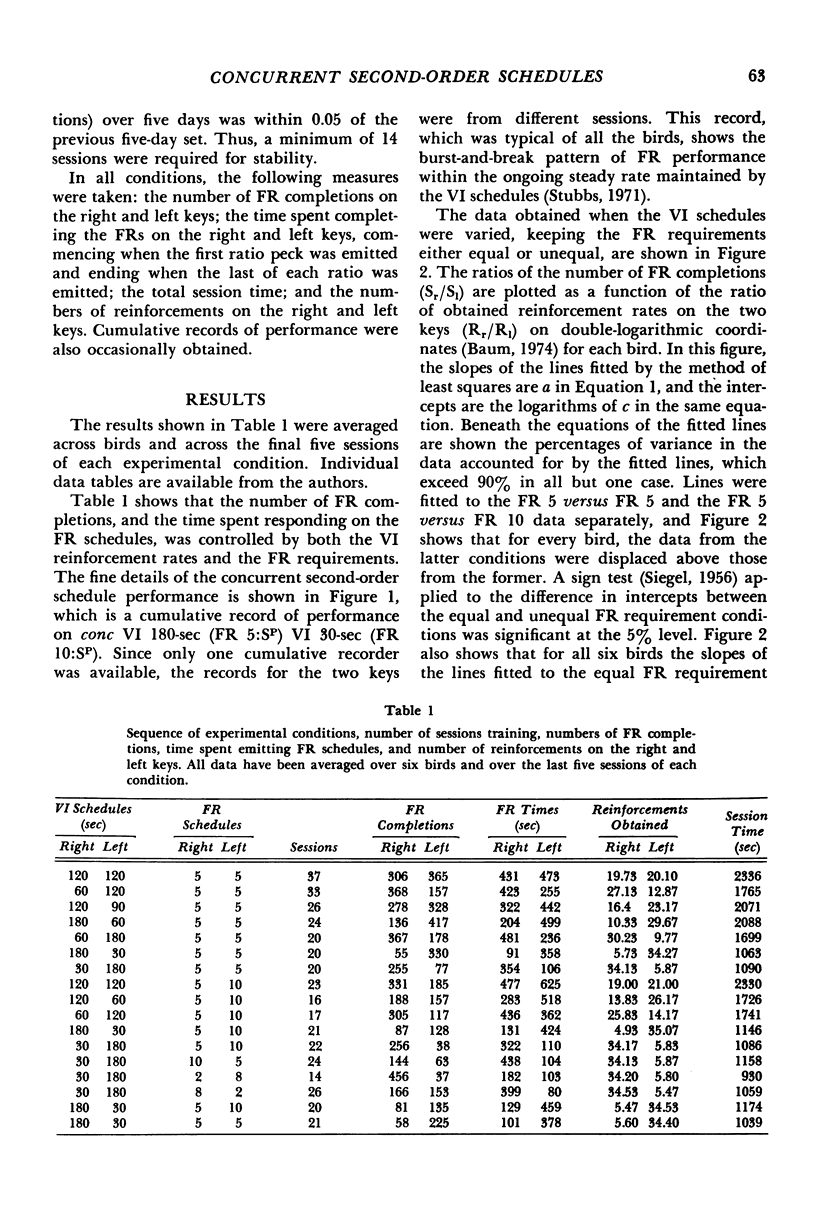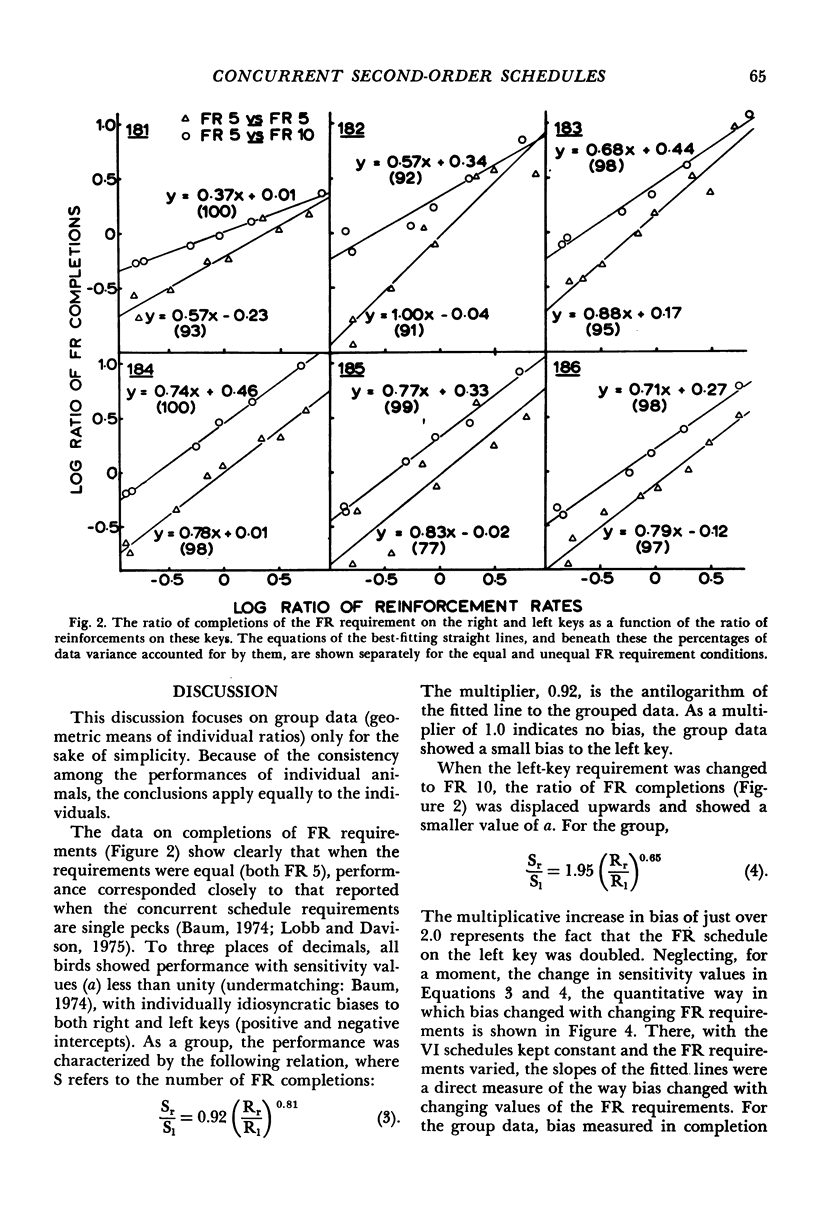Abstract
Six pigeons were trained on two-key concurrent variable-interval schedules in which the required response was the completion of a fixed number of key pecks. When the required number of pecks was equal on the two keys, response- and time-allocation ratios under-matched obtained reinforcement rate ratios. A similar result was found when the required number of pecks was unequal, except that performance, measured in response terms, was biased to the shorter required number of pecks and was less sensitive to reinforcement-rate changes. No such differences were found in the data on time spent responding. When the variable-interval schedules were kept constant and the required numbers of pecks were systematically varied, response ratios changed inversely with the ratio of the required number of pecks, but time-allocation ratios varied directly with the same independent variable. Thus, on response measures, pigeons “prefer” the schedule with the smaller peck requirement, but on time measures they “prefer” the schedule with the larger peck requirement. This finding is inconsistent with a commonsense notion of choice, which sees response and time-allocation measures as equivalent.
Keywords: concurrent schedules, second-order schedules, matching law, time allocation, pecking, pigeons
Full text
PDF








Selected References
These references are in PubMed. This may not be the complete list of references from this article.
- Baum W. M. On two types of deviation from the matching law: bias and undermatching. J Exp Anal Behav. 1974 Jul;22(1):231–242. doi: 10.1901/jeab.1974.22-231. [DOI] [PMC free article] [PubMed] [Google Scholar]
- Baum W. M., Rachlin H. C. Choice as time allocation. J Exp Anal Behav. 1969 Nov;12(6):861–874. doi: 10.1901/jeab.1969.12-861. [DOI] [PMC free article] [PubMed] [Google Scholar]
- Baum W. M. Time allocation in human vigilance. J Exp Anal Behav. 1975 Jan;23(1):45–53. doi: 10.1901/jeab.1975.23-45. [DOI] [PMC free article] [PubMed] [Google Scholar]
- Bauman R. A., Shull R. L., Brownstein A. J. Time allocation on concurrent schedules with asymmetrical response requirements. J Exp Anal Behav. 1975 Jul;24(1):53–57. doi: 10.1901/jeab.1975.24-53. [DOI] [PMC free article] [PubMed] [Google Scholar]
- CATANIA A. C., CUTTS D. Experimental control of superstitious responding inhumans. J Exp Anal Behav. 1963 Apr;6:203–208. doi: 10.1901/jeab.1963.6-203. [DOI] [PMC free article] [PubMed] [Google Scholar]
- Chung S. H., Herrnstein R. J. Choice and delay of reinforcement. J Exp Anal Behav. 1967 Jan;10(1):67–74. doi: 10.1901/jeab.1967.10-67. [DOI] [PMC free article] [PubMed] [Google Scholar]
- Cohen S. L. Concurrent second-order schedules of reinforcement. J Exp Anal Behav. 1975 Nov;24(3):333–341. doi: 10.1901/jeab.1975.24-333. [DOI] [PMC free article] [PubMed] [Google Scholar]
- Davison M. C. A functional analysis of chained fixed-interval schedule performance. J Exp Anal Behav. 1974 Mar;21(2):323–330. doi: 10.1901/jeab.1974.21-323. [DOI] [PMC free article] [PubMed] [Google Scholar]
- HERRNSTEIN R. J. Relative and absolute strength of response as a function of frequency of reinforcement. J Exp Anal Behav. 1961 Jul;4:267–272. doi: 10.1901/jeab.1961.4-267. [DOI] [PMC free article] [PubMed] [Google Scholar]
- Herrnstein R. J. Formal properties of the matching law. J Exp Anal Behav. 1974 Jan;21(1):159–164. doi: 10.1901/jeab.1974.21-159. [DOI] [PMC free article] [PubMed] [Google Scholar]
- Herrnstein R. J. On the law of effect. J Exp Anal Behav. 1970 Mar;13(2):243–266. doi: 10.1901/jeab.1970.13-243. [DOI] [PMC free article] [PubMed] [Google Scholar]
- Hollard V., Davison M. C. Preference for qualitatively different reinforcers. J Exp Anal Behav. 1971 Nov;16(3):375–380. doi: 10.1901/jeab.1971.16-375. [DOI] [PMC free article] [PubMed] [Google Scholar]
- Lobb B., Davison M. C. Performance in concurrent interval schedules: a systematic replication. J Exp Anal Behav. 1975 Sep;24(2):191–197. doi: 10.1901/jeab.1975.24-191. [DOI] [PMC free article] [PubMed] [Google Scholar]
- Nevin J. A. Rates and patterns of responding with concurrent fixed-interval and variable-interval reinforcement. J Exp Anal Behav. 1971 Sep;16(2):241–247. doi: 10.1901/jeab.1971.16-241. [DOI] [PMC free article] [PubMed] [Google Scholar]
- Stubbs D. A., Pliskoff S. S. Concurrent responding with fixed relative rate of reinforcement. J Exp Anal Behav. 1969 Nov;12(6):887–895. doi: 10.1901/jeab.1969.12-887. [DOI] [PMC free article] [PubMed] [Google Scholar]
- Stubbs D. A. Second-order schedules and the problem of conditioned reinforcement. J Exp Anal Behav. 1971 Nov;16(3):289–313. doi: 10.1901/jeab.1971.16-289. [DOI] [PMC free article] [PubMed] [Google Scholar]
- Trevett A. J., Davison M. C., Williams R. J. Performance in concurrent interval schedules. J Exp Anal Behav. 1972 May;17(3):369–374. doi: 10.1901/jeab.1972.17-369. [DOI] [PMC free article] [PubMed] [Google Scholar]


